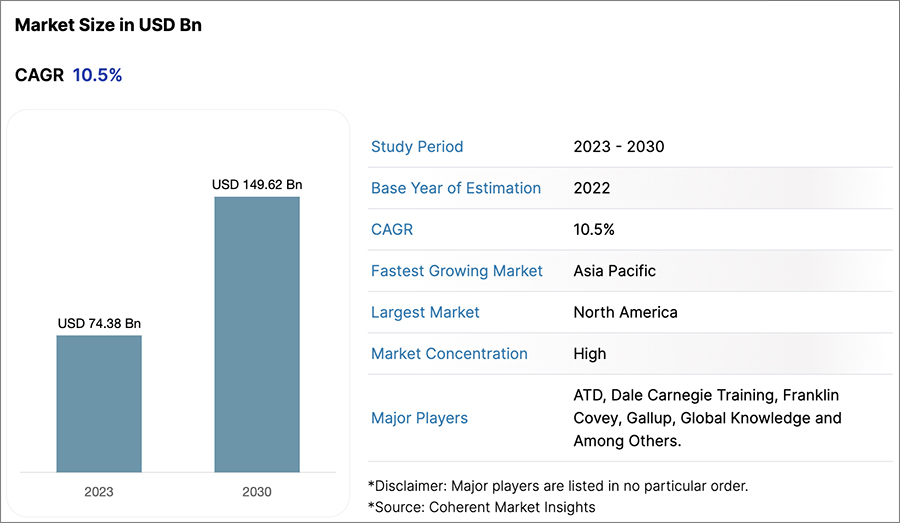"A leader takes people where they want to go. A great leader takes people where they don’t necessarily want to go, but ought to be."
- Rosalynn Carter
Identifying and grooming future leaders is a “3C” task – constant, critical, and challenging – and the demand for effective leadership today across all industries is as high as it has ever been. So, it’s not surprising that the training and development market is thriving and growing quickly, with total corporate investment projected to double from $75 billion to $150 billion in just the next six years.
Global Leadership Development Exercise Market Size
Source: https://www.coherentmi.com/industry-reports/global-leadership-development-exercises-market
What is surprising, however, are the disappointing returns companies are getting back on these investments, reflected in recent Gallup polling showing significant declines in both employee engagement and confidence in leadership. A full two-thirds (67%) of employees say they are not engaged in their jobs, and one in five (17%) are actively disengaged. In terms of leadership, two-thirds (65%) would forgo a pay raise or a promotion for a new leader, and of those that resigned in the past year, eight in ten (80%) cited issues with their supervisors as the main reason. In our experience working with manufacturing companies, a big contributor to turnover issues or absenteeism on the factory floor is dissatisfaction with the supervisor or management.
Houston, we have a leadership development problem.
But there is a silver lining, and it involves history. Not a moon landing but simply the fact that businesses of all types and sizes have always struggled with the process of identifying and training their future leaders. Which means that many smart minds before us have delved deeply into these issues and put forth solutions. Sure enough, a quick Google search for “leadership development” confirms this with more than three billion individual results. Ironically, the most consistently effective leadership program in business history, the Training Within Industry (TWI) framework developed by the US Department of War during World War II, narrows the scope down to just three components: how to instruct (TWI Job Instruction), how to lead (TWI Job Relations), and how to improve a process (TWI Job Methods). The TWI program breaks it down even further to these five essential leadership ingredients:
- Knowledge of the work
- Knowledge of responsibilities
- Skill in leading
- Skill in instructing
- Skill in process improvement
Road to Improvement
Improvement, as always, begins by acknowledging and pinpointing flaws, and many smaller and medium-sized manufacturers have trouble seeing these issues because long-held perceptions and practices tend to cloud the view. But if companies want to turn these poll numbers around, they need to remove these blind spots and do some internal due diligence on their supervisor or leadership selection process and strategy. To be kind, the approaches are all over the place and what usually ends up happening is the star performers get promoted to higher-paying leadership roles because the company wants to keep an invaluable asset.
What companies fail to realize when they do this, however, is that in many cases they are devaluing that asset and causing collateral damage to the broader team. Hence the disturbing engagement trends. The connection? Many of these individual contributors turned supervisors come into their management roles with strong knowledge of the work and the responsibilities (TWI ingredients 1, 2), but lack the experience and skills necessary to lead, instruct and develop, and improve (TWI ingredients 3, 4, 5). This imbalance becomes glaring quickly because employees value and need good leadership. When it’s not in a good place, nobody benefits. The manager who got promoted appreciates the recognition but is instantly thrust into an uncomfortable situation because they know they are over their heads with the new supervisory responsibilities.
A Tried-And-True Playbook to The Rescue
The TWI framework has roots going back to the early 1900s, and the teachings of one of Bethlehem Steel’s early leaders. In 1940, amid World War II and the civil draft, the War Department officially established the Training Within Industry service to ensure that essential manufacturing operations continued to keep pace with demand despite the worker shortage. The effort brought together the best and brightest academics and practitioners to figure out and document how to teach people to learn new skills and become effective leaders faster than they ever had. It worked so brilliantly that TWI eventually became the foundation for the kaizen/continuous improvement process, and well-known lean companies such as GE and Toyota built their global leadership development strategies from the ground up around the TWI philosophy.
Let’s run through the five essential TWI leadership ingredients in more detail:
- Knowledge of the work.
This one is straightforward. If you’re a supervisor in a factory that makes air conditioners, you need to be expert not only in how the units themselves function but intricately familiar with how they are built, including every component inside and out and any integrated technologies. - Knowledge of the responsibilities.
Continuing with the same scenario, this entails having a strong understanding of how the entire AC factory works, in other words knowing which areas do what. Who installs the electronics? Who sets the policies and procedures and what are they? Who helps with these supply chain issues? How are we sourcing materials? Leaders should serve as their team’s internal GPS and need to establish collaborative relationships with other senior leaders. - Skill in leading.
There are many definitions of a skilled leader, but one that has always resonated came from Jeff Immelt, who said the true skill lies in being able to obtain the ‘willing cooperation’ of others. Just like these TWI ingredients, precise and simple, and so true. Getting people to want to follow instead of following along because they need to is the goal, but it involves taking the time to get to know the different personalities and work styles of various team members. - Skill in instructing and developing.
This is where the star performer who gets promoted can really get in deep. They typically come to their management roles knowing their job inside and out, an expert craftsman in what they do. But can they effectively coach and transfer their knowledge that motivates an individual or team to develop their skills? The two disciplines are quite different; instructing requires different interpersonal skills and patience as people move up the learning curve. - Skill in process improvement.
Supervisors who not only say they will support their employees but who follow through with real action will gain trust, credibility, and respect more quickly. Leaders should never underestimate the value of letting employees know that they’re always thinking about how to drive improvements that make their daily tasks – from the mundane to the most important – a little bit easier.
Time to Act
Retaining good employees is essential, and the fact that so many are comfortable voicing their displeasure with their supervisors shows that we are at an important crossroads in the evolution of how leaders are chosen in the first place. The old ways of doing things aren’t working anymore and it is time for change. The beauty of the TWI approach is that it puts potential leaders through this five-ingredient filter, and if the person is only strong on 1 and 2, the program can be customized to focus on 3 through 5. Now is a good time for manufacturers to examine their leadership development and coaching models to see how they can make them deliver much better results. Programs such as TBM’s Supervisor Academy are a good first step in helping companies develop leaders from the shop floor.






